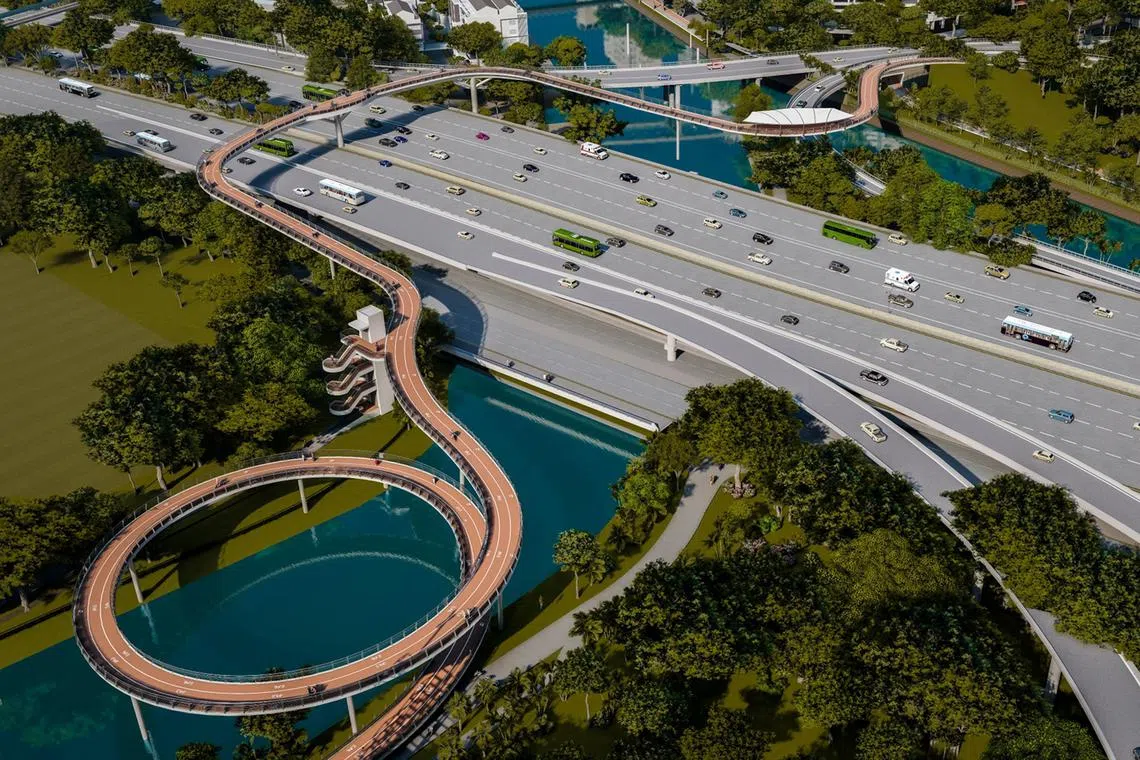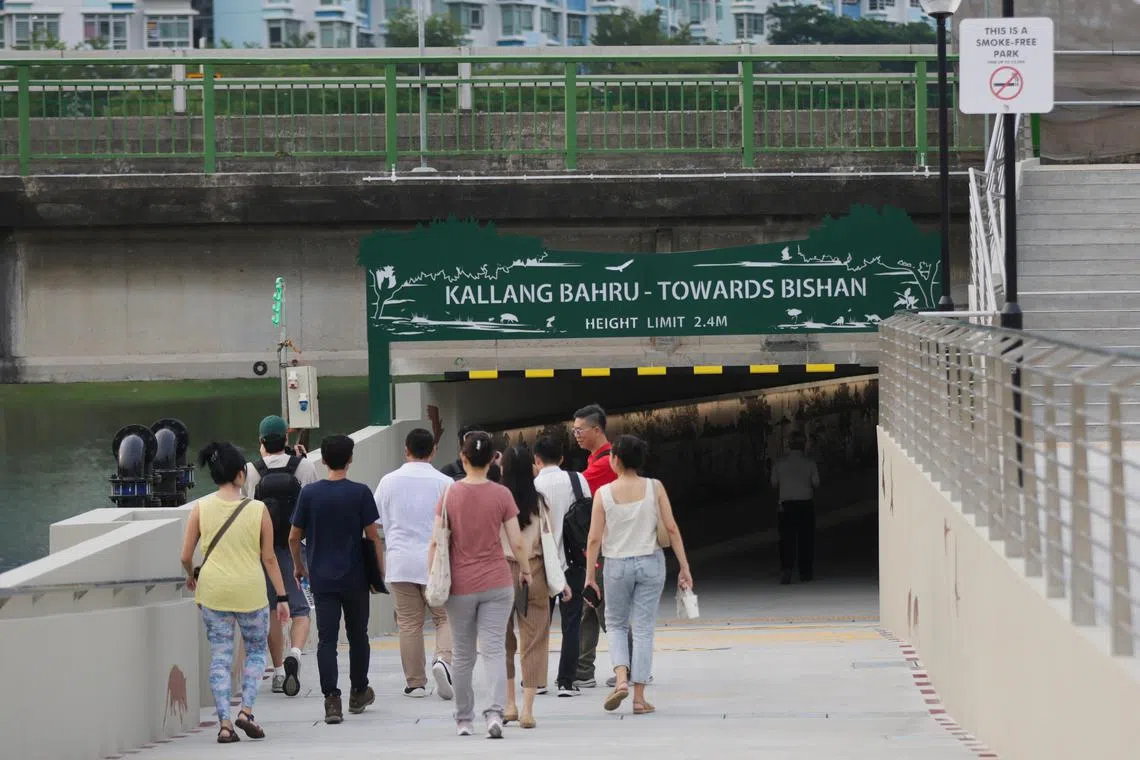Bishan-to-city cycling route years in the making and still has some way to go
Sign up now: Get ST's newsletters delivered to your inbox

The improved underpass under the Central Expressway near Lorong 8 Toa Payoh, where headroom has increased from 1.9m to 2.4m.
ST PHOTO: GIN TAY
Follow topic:
SINGAPORE – While excavating beneath a section of Kallang Bahru Road to build a new underpass that would make cycling there more seamless, the Urban Redevelopment Authority (URA) and its contractors made an unexpected discovery.
They found what appeared to be an abandoned water pipe that was not in any of the utility plans, and had to scramble to find out who it belonged to before they could continue with construction.
It was a similar story with the existing underpass beneath the Central Expressway near Lorong 8 Toa Payoh, which the URA wanted to deepen and widen.
Drainage pipes left over from earlier works to expand the expressway were found, and they had to be removed before excavation could carry on.
These surprises, as well as manpower shortages due to Covid-19, were among the challenges in the construction of five new and improved connections on the Bishan-to-city cycling route.
Mooted by URA eight years ago in 2015, these infrastructural improvements were presented to the public for feedback at an exhibition in 2017, before a tender was called in 2020.
The five connections were opened to the public last Thursday, after more than two years of construction.
But an even bigger challenge in the Bishan-to-city cycling route awaits URA’s engineers, with a tender called last Thursday to build a 682m-long cycling bridge
The elevated bridge will be the longest of its kind here, and will form part of a new 1.2km link that will allow pedestrians and cyclists to travel seamlessly between the park connector next to St Andrew’s Junior College and the neighbourhood park in Jalan Taman near Serangoon Road.

A tender was called on Oct 5 to build a 682m-long cycling bridge spanning a 14-lane section of the Pan-Island Expressway by 2027.
PHOTO: URA
It is the final piece of URA’s plan to turn the Kallang Park Connector into a 10km-long seamless commuting route.
Mr Wong Kia Fu, an executive civil engineer at URA, has been working on the PIE link project since it was proposed in 2015.
He told The Straits Times that the initial focus was on the Bishan-to-city route itself – how best to get pedestrians and cyclists from one point on the Kallang Park Connector to the next, and get around the expressways and major roads interrupting the route.
He said: “From then on, the team had to work on the actual structural design of the bridge. During that stage, we uncovered additional challenges, and we found out more about the underground services at the site.
“There are fibre optics and electrical cables, water pipes and so on. All this adds another dimension of complexity to the project.”
In 2020, the URA said it needed more time to conduct more in-depth studies on the PIE bridge, citing the complex nature of carrying out construction over live traffic.
What resulted was a refinement of the bridge’s design to one that is more conventional but easier and safer to construct, and also easier to maintain.
The initial idea was to build a cable-stayed bridge, similar to the Keppel Bay Bridge, across the PIE.
Early artist impressions showed three slim pylons rising above the expressway with the cycling bridge suspended below.
Ms Koh Siew Lay, architect and lead consultant for the Bishan-to-city project, said this is still her preference as a cable-stayed bridge is a more elegant and iconic structure.
But the region director of AWP Architects, which won the bid to design the Bishan-to-city route, said the site constraints at the PIE meant that it was not possible to implement this concept.
“Because of the complexity of the erection of pylons, which needs more space on the road for construction, it requires the closing of traffic lanes at times, which will compromise traffic flow on the PIE”, she added.

The entrance to a new underpass in Kallang Bahru Road, part of the Bishan-to-city cycling route.
ST PHOTO: GIN TAY
The project team’s hands are also tied, as running in the vicinity of the PIE is the PUB’s D eep Tunnel Sewerage System.
Said Ms Koh: “We have to respect the boundaries, so we had a lot of challenges in how we could support the proposed structure and where we could place the columns.”
Mr Wong said the final design of the cycling bridge allows longer segments to be hoisted each time, minimising the risk to traffic below.
“Of course, during hoisting works, the road will need to be closed, but we will plan it in advance and communicate it to the public. It will be done in stages, and only during off-peak periods in the middle of the night for a few hours,” he added.
According to the tender for the PIE bridge, which closes on Oct 30, the centre column of the bridge will be located in the narrow centre divider of the PIE.
To create working space for the construction of this centre column, a section of the expressway towards Tuas will need to be temporarily diverted.
Another consideration during the design process was the gradient of the elevated ramps, which will reach a height of 14m.
Mr Wong said: “If we make a ramp very gentle, that means the ramp needs to be very long. So we needed to find a sweet spot where people can climb at a gradient that is not so steep, but also at a comfortable distance.”
Mr Kelvin Phang, 52, founder of active mobility app Ridenjoy, said the new improvements to the Bishan-to-city route have shaved about 20 minutes off his usual cycling commute from his home in Ang Mo Kio to Funan mall, where he showers before going to his office in nearby Peninsula Plaza.
On the planned PIE bridge, Mr Phang said it will help to move cyclists away from the junction of MacPherson Road, Bendemeer Road and Upper Serangoon Road, which many people use to get across the PIE now.
“I have seen many novice cyclists almost get knocked down because they are deceived by the traffic lights there... The PIE bridge will finally remove this potentially dangerous spot,” he said.

Mr Francis Chu, 63, co-founder of recreational cycling group Love Cycling SG, said he understands why cyclists will need to wait until 2027 for the new PIE bridge, given the scale of construction.
But he noted the community had flagged this bottleneck more than 10 years ago, so for some it is coming a bit late.
In the interim, he suggested that URA, the Land Transport Authority or the National Parks Board could make existing detours more visible and recognisable, so it is less confusing.
Mr Chu noted how the new cycling bridge serves as a public statement to the Government’s commitment to promoting cycling as a viable mode of transport.
“There is this intangible value to it,” he added.
He said the authorities should also not forget about the everyday difficulties faced by cyclists.
“One idea that I try to bring up every time is to have continuous cycling paths.”


